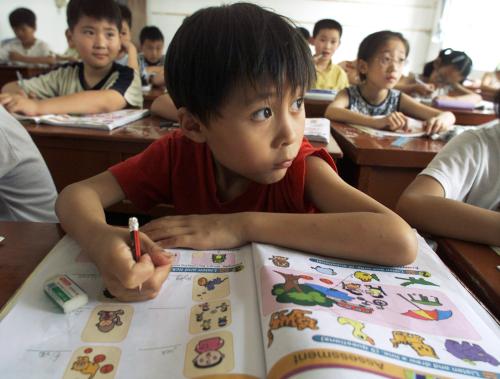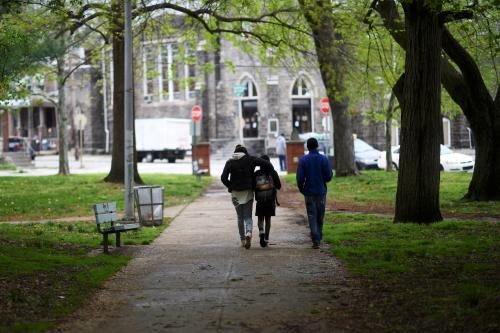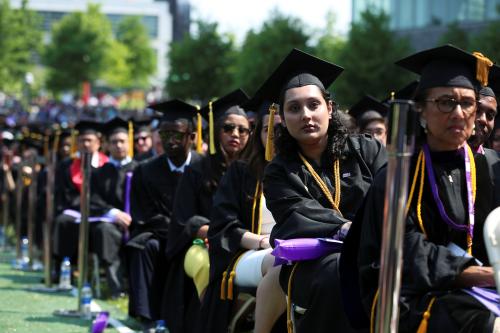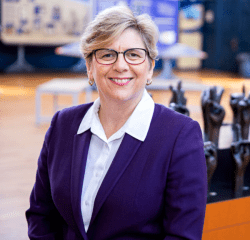The Los Angeles Unified School District (LAUSD), the second largest school district in the country, recently passed a new policy that is a model for enhancing brain, language, and socio-emotional development of all deaf, hard of hearing, and deafblind children (hereafter referred to collectively as “deaf”). This policy, while not new in American education, is new for such a large public school district and an important bellwether for advancing early and consistent language acquisition for deaf children.
LAUSD’s policy focuses on American Sign Language (ASL)-English bilingual education and says that all deaf children are eligible to receive services through public schools from birth. For children up to age three, bilingual programs will be the default, with an opt-out option. This bilingual ASL/English approach evades the centuries-long binary trap that insists that deaf people must either learn to speak or learn to sign, not both. A bilingual approach addresses the isolation and exclusion deaf children frequently experience in classrooms and school environments. It creates a more inclusive and supportive learning environment for children, families, professionals, and school programs, building skills and knowledge that will be used throughout life. This is validated by significant research, including cognitive neuroscience studies about language development, such as the ones promulgated by the Visual Language and Visual Learning Center, a National Science Foundation Science of Learning Center housed at Gallaudet University.
Research validates the benefits of visual learning for ALL children.
In my 2016 article, “Dispelling the Myths of Language Acquisition,” I highlight the abundance of scientific evidence regarding the biological foundations of human language, including sign language, reading, and bilingualism that shows that early exposure to both ASL and English is beneficial for all children. Deaf children who are not provided early language exposure to visual language face lifelong consequences to brain development, learning, and higher cognition. For their young brains, early sign language exposure is as biologically imperative as early spoken language exposure. The more we engage deaf children in language-rich ASL/English experiences, the stronger their brains and language skills become. Some of the key discoveries include:
- The brain does not prioritize spoken language. Sign languages and spoken languages are processed in the same areas of the brain.
- Exposure to sign language does not delay spoken language development. Further, early exposure to ASL supports better vocabulary and reading skills compared to hearing peers learning only English.
- Bilingual deaf children have identical benefits to those found in children who are bilingual in other languages, including more robust use of the language areas of the brain, enhanced social and interpersonal understanding, and stronger language analysis, reading, and reasoning skills.
- Parents of young deaf children who are learning sign language do not need to achieve immediate and full fluency during this timeframe for their children to benefit from early exposure to ASL.
- Young deaf children exposed to signed languages achieve every milestone on the same timetable as young hearing children exposed to spoken languages. The signed and spoken language timing windows are identical.
Neuroscience and research show the critical importance of bilingual learning and must guide policies and practices in deaf education.
Bilingual (ASL & English) education policy
The binary logic of using either spoken or signed language, instead of a more inclusive practice with both languages, has caused generations of harm to deaf people. Science and practice must be anchored in our policies and advance bilingual education for deaf children.
Multiple critical policy areas need to be addressed to ensure that our diverse deaf children can thrive from the beginning. Three in particular are:
1. Interpret the Least Restrictive Environment (LRE) provision in the Individuals with Disabilities Education Act (IDEA) to require ASL/English language-rich environments for all deaf students and continue to expand options for language-rich bilingual educational learning environments.
Current interpretations of LRE frequently require deaf students to “fail” in mainstream settings (the only deaf child in a classroom of hearing peers) before they can be moved to language-rich bilingual learning environments (i.e., they must demonstrate insufficient academic progress, often for a year or longer, causing them to fall even further behind in their education). Originally designed to stop the segregation of children with disabilities, LRE has become a one-size-fits-all approach, creating restrictive learning environments especially harmful for deaf children. The LRE for deaf children is the environment in which they have full access to direct instruction from teachers and engagement with their peers without the use of an interpreter as a third party. The richest bilingual language environment possible throughout their educational journey will create the highest degree of success for deaf children, but current policies do not reflect this.
An increase in the number of bilingual visual learning environments for deaf and hard of hearing students in every state is critically needed. Successful model bilingual education programs around the United States are available to support innovative strategies. For example, at Gallaudet University, our Laurent Clerc National Deaf Education Center and the Alabama Institute for Deaf and Blind are leading a Regional Early Acquisition of Language initiative collaborating with states, schools, families, and communities to create early access to language pathways and resources. We invite leaders, educators, and policy makers to collaborate with these and other bilingual resources throughout the country to create ASL/English language-rich environments for their deaf students.
2. Count deaf children.
There is no systematic data collection effort that identifies where deaf children are, what services they are receiving, and how they are progressing educationally compared to their peers. We cannot enact good policy, ensure educational learning opportunities, and provide adequate support without accurate counts of our deaf children in schools across the country. We must develop a unified strategy to achieve this in a collective and appropriate way that benefits deaf children, their families, and the schools, professionals, and organizations that serve these students.
3. Confront barriers in teacher screening requirements.
There is a dire need for more deaf and sign language-fluent teachers, who are critical language and life role models for their deaf students. Yet, as is seen with other minorities, bias in teacher screening exams and other practices create unnecessary barriers for people who are outstanding teachers to become certified. We need a greater diversity of measures and evaluative tools to ascertain the quality and skill of educators to assure that we have a strong future educational workforce.
I am deeply grateful for the deaf family and community in which I was raised. I learned ASL and English at the same time, living a truly bilingual experience. I attribute my lifetime of academic and professional success to this direct access to language and learning from birth. However, I attended public schools without any accommodations because people believed that I had enough hearing to “get by” and survive.
There were many costs.
No one, not once, asked me to share my knowledge in ASL and English. By my junior year, in what I might now call an unconscious rebellion, I chose to give an extemporaneous speech using both ASL and English in a Forensics competition. Ironically, the topic was about American Sign Language. I won the state championship. What better validation could we receive about the power of developing bilingually?
My personal educational experiences led me to get involved in opening Metro Deaf School in 1993. It was one of the earliest bilingual charter schools in the country and the first to teach in ASL and English. I believed then, as I do now, that we must show excellence in bilingual education for deaf children and steer away from restrictive environments that too often lead to failure. It is possible. Many successful professionals like me benefitted from early visual language access, exposure to English through reading, writing, and spoken English, and the subsequent brain development and critical thinking skills that followed. Let’s make this path of professional success a possibility for every deaf, hard of hearing, and deafblind child.
The International Day of Sign Languages is Sept 23, 2022.
Roberta “Bobbi” J. Cordano is the first deaf woman president of Gallaudet University, the only birth-PhD education entity in the world that uses American Sign Language in every aspect of its daily education and operations. Her prior experiences include roles as a Minnesota assistant attorney general, vice president of the Amherst H. Wilder Foundation, educational administrator at the University of Minnesota, and a founder of two charter schools.
The Brookings Institution is committed to quality, independence, and impact.
We are supported by a diverse array of funders. In line with our values and policies, each Brookings publication represents the sole views of its author(s).








Commentary
Why does inclusion often neglect the needs of deaf students?
September 22, 2022